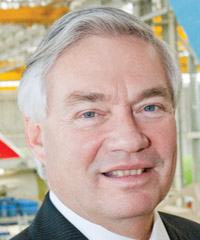20th Anniversary Issue
October 1st 2013
It’s where the action will beRead More »
Think tanks produce dazzling technological visions of aviation in 2033. It is a world of gleaming, blended wing technology, ultra sleek and sexy aircraft cabins and hypersonic travel that will link continents in a few hours.
The reality is not so romantic, but it will still be remarkable. Airlines, and the passengers they carry, will have made the dramatic changes in the way they travel - and changes [mostly] will be for the better.
 |
| Ray Conner, President & CEO, Boeing Commercial Airplanes: unprecedented advances for the company in the next 20 years |
Boeing Commercial Airplanes president and CEO, Ray Conner, told Orient Aviation: “While the advances [Boeing] have made over the last 20 years have been remarkable, the next 20 years promises to be unprecedented.”
Most experts concur that by 2033 big jets will look much the same as they do today. The differences will be in the detail. New aircraft will be almost entirely built from lightweight composite materials. Engine technology will have advanced to a point where taking off and landing is so quiet, curfews will not be required.
Engines will be more powerful, possibly using breakthrough ceramic technology that can operate engines at higher temperatures. Planes will be able to travel longer distances between destinations – though not much faster – linking any two points in the world in a non-stop hop.
“Where we are seeing a revolution underway is in our ability to harness advances in new materials, manufacturing, avionics and propulsion technologies. These kind of improvements are resulting in transformational changes in operational efficiencies, environmental impact and passenger comfort,” said Conner.
Much of these technological advances, along with the use of biofuels, will be closer to achieving carbon neutral flight.
Within the next two decades, it is expected technology will have brought the International Air Transport Association’s (IATA) Checkpoint of the Future to airports across the world, seeing off the annoying airport security queue.
Checking in for a flight remotely will be the norm and arriving, transiting and departing from airports will be fully automated.
Twenty years ago, when Orient Aviation was first published, the mobile phone was in its infancy and the tablet was something you took for medicinal purposes. Smart phones arrived in the world around the turn of the century and 2G technology introduced SMS and mobile phone internet access to everyday life. Today, 4G is on the near horizon.
The impact of this technology and the opportunities it will give to airlines to market and manage their growth through social media technology is exponential, but SITA forecasts that as soon as 2016, the industry will see a major transformation in the way passengers buy travel services and use self-service along their journey.
In the Airbus global media forecast released last month, the aircraft manufacturer said: “By 2032, the Asia-Pacific will lead the world in traffic. Today, on average, a fifth of the population of the emerging market nations take a flight annually. By 2032, this will swell to two thirds.
“The attraction of air travel means passenger numbers will more than double from today’s 2.9 billion to 6.7 billion.”
 |
| John Leahy, Chief Operating Officer Customers, Airbus: Asia-Pacific is where the action will be in the next 20 years |
Airbus said India was growing at the fastest rate (almost 10% per year) followed by China at 7%. “Overall,” said Airbus, “the Asia-Pacific will account for 36% of all new passenger aircraft demand.” Europe will be 20% and North America 19%.
In the very large aircraft market, the region will provide 47% of demand. In the twin-aisle sector, 48% of deliveries will be to the Asia-Pacific in the next two decades, with Europe (15%) and the Middle East (13%) trailing far behind.
Airbus forecasts low-cost carriers will increase their market share to 21% in the next two decades.
“The Asia-Pacific is where the action will be in the next 20 years,” said John Leahy, Airbus chief operating officer, customers. “Reflecting a high level of urbanization [in the region], air traffic will be concentrated around a growing number of major cities. As a result, larger and more efficient aircraft will be the only way to meet demand while overcoming airport constraints.”
For Randy Tinseth, vice-president marketing at Boeing Commercial Airplanes, the Asia-Pacific growth figures are a no brainer. “Asia is the biggest market by demand, the biggest market for narrowbodies and the biggest market for widebodies. It’s really special that way,” he said.
Vice-president sales at Boeing Commercial Airplanes, John Wojick, told Orient Aviation that “by 2032, nearly half the world’s air traffic growth will be passengers travelling to, from, or within the Asia-Pacific, with the region experiencing average economic growth of 4.6% per year, which is much higher than the world average”.
Despite being more efficient and hopefully more fiscally stable, Asia-Pacific airlines will face many of the problems in 2033 that confront them today.
It is likely bilateral air agreements will continue to rule the skies. There will be more consolidation, but many countries will still resist pressure to open up to cross-border takeovers.
The sovereignty of a nation’s skies will persist. Yet it is probable that more of the region’s government-owned airlines will cross into private hands as politicians finally realize a commercially run airline is a more profitable airline.
“An important policy issue that needs to be addressed is greater liberalization of international aviation,” said Andrew Herdman, the director general of the Association of Asia-Pacific Airlines (AAPA).
“Further rationalization of the current highly fragmented industry structure would deliver greater efficiencies and eventually bring the airline industry more into line with other globalized business sectors.
“One major challenge will be how to ensure the necessary aviation infrastructure, including airports and air traffic management capabilities, keeps pace with the projected growth in demand for air travel.”
Said Boeing’s Tinseth: “The Chinese have worked really hard and have gotten out front, showing a willingness to invest in infrastructure. But if you look at some of these other markets, these big growth markets such as Indonesia, infrastructure is going to be a big challenge.”
Mark Dunnachie, Embraer’s vice-president Asia-Pacific commercial aviation, said there will be 505 30-120 seat new jets in the region in the next two decades.
“Looking at the broader dynamics of the region’s market, we see the right sizing argument as the key to market growth. We are experiencing a clear understanding from airlines that the customer wants frequency.
| The only way is up “Airplanes 20 years from now will be more capable. Firstly, they will be slightly larger than airplanes today. Airline customers will find ways to get load factors up even further than they are today. “Airplanes will be used at higher utilization and be in service more days per year. We will see the average range of airplanes increase. The capabilities of the airplane will improve and be able to generate 30% more available seat kilometres. And that’s a big deal.” Randy Tinseth
Vice-President Marketing, Boeing Commercial Airplanes |
“We are seeing an increasing appetite for jet connections from routes that until now were sustained by older turboprops, leaving passengers with little choice and less comfort.”
The extraordinary surge in airline traffic in the Asia-Pacific will travel in parallel with the industry’s global drive to bring down the emissions it produces. Propulsion manufacturers are responding to demands of airlines for more fuel efficient engines and lower MRO costs – or time on the ground - for very expensive airliners.
“China’s current fleet is just over 2,000 and we anticipate it growing to more than 7,000 by 2030,” Christopher Beaufait, GE Aviation’s president of commercial aviation programmes in Greater China, told Orient Aviation.
“We are seeing record order activity. During the next four years, the fleet of GE and CFM engines will grow from about 3,600 engines to 5,000 engines.
Industry and political pressure to meet lower emissions targets accelerated the development of Pratt & Whitney’s turbofan PurePower engine. Said the engine manufacturer’s chief operating officer, Paul Adams: “Our game-changing engine uses a gear system that allows a rotation speed of the turbofan and the low pressure turbine to be optimized independently. The increased engine bypass ratio produces less fuel burn, less noise reduction and lower maintenance costs.” The PurePower engine flew on Bombardiers’ maiden CSeries jet flight in September.
At Snecma, the rapid urbanization of the region has meant aggressive development of point-to-point routes up to 3,000 miles, said the manufacturer’s executive vice-president, commercial engines, Francois Planaud.
The Snecma/GE joint venture enginemaker, CFM, has received 2,100 firm orders and commitments for its new generation LEAP engine, answering the need from this very critical regional market, said Planaud.
Sufficient numbers of pilots and technicians must be trained and qualified to maintain the huge fleet expansion in the region, said AAPA’s Herdman.
It will require additional investment, a planning tenet that GE China endorses. China produces 700,000 engineers annually. The rest of the world produces 100,000 each year.
GE believes this talent pool could transform China from a low-cost global supplier to a worldwide, hi tech producer of technology.